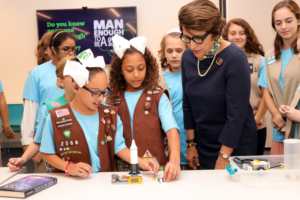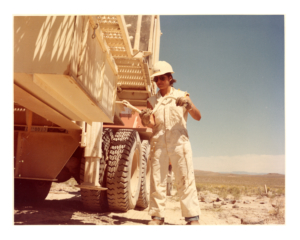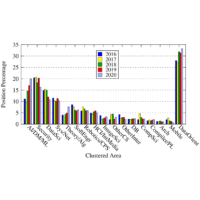Expanding the Pipeline: Girl Scouts – Building the STEM Leaders and Workforce Talent of the Future

“Girl Scouts is also where I realized that I was not only interested in science and math—I was good at them” – Sylvia Acevedo, CEO Girl Scouts of the USA
As CEO of Girl Scouts of the USA and a lifelong Girl Scout, and thanks to my successful business tech career, I am in a position to give back to an organization that gave me so much. It was at Girl Scouts that I first discovered my passion for space and astronomy, during a troop camping trip when I was a seven-year-old Brownie and my troop leader noticed my fascination with the night sky. She pointed out the constellations to me and, as I gazed wide-eyed into the New Mexico sky, explained how there were whole systems out there for the exploring.
Girl Scouts is also where I realized that I was not only interested in science and math—I was good at them. Through my badge experiences, like the one where I earned my Science badge by building and launching an Estes Rocket after much trial and error, I developed the persistence and resilience that I have relied upon my entire career as a rocket scientist, engineer, and tech executive.
Now it’s my personal mission to ensure that today’s girls have every opportunity to discover and cultivate their passions, to dream big, and to succeed and thrive in whatever path they choose—especially in STEM fields.
Although Girl Scouts has always offered valuable hands-on STEM experiences—among our first badges were pilot, carpentry, and electrician—in the past few years we have undergone a STEM revolution. In the last year alone, girls have earned nearly 1 million STEM badges in robotics, coding, computer programming, mechanical engineering, space science, environmental advocacy, and cybersecurity.
These are incredible numbers, and they underscore the fact that our programming is really resonating with girls. By summer of 2020, girls from kindergarten through 12th grade will be able to earn 129 STEM badges and awards.
So how do we at Girl Scouts ensure that we are staying relevant to girls’ lives and offering the kinds of impactful experiences they want? Through regular customer surveys and groundbreaking original studies conducted by our Girl Scout Research Institute (GSRI), we are able to gain critical data-driven insights, measure the impact of Girl Scout programming, and lead national conversations about girls and their development. The findings also ensure that girls’ wants and needs are at the center of our programming.
 One reason there is such a gender gap in STEM is that the curricula have been written around what boys are familiar with and what interests them—they are the default student. This means that when a school or nonprofit rolls out a curriculum that has been developed around what boys are familiar with and interested in, boys immediately gravitate to it. It is familiar, they’re confident in its use, and they develop competence. On balance, girls are exposed to different experiences than boys in play and education, so it’s natural that if criteria is based on boys’ skills as a model, they will appear to come in lower in competency and agility. The result is, the girl and her teacher look at the difference in their results and say, “I guess girls aren’t good at STEM.”
One reason there is such a gender gap in STEM is that the curricula have been written around what boys are familiar with and what interests them—they are the default student. This means that when a school or nonprofit rolls out a curriculum that has been developed around what boys are familiar with and interested in, boys immediately gravitate to it. It is familiar, they’re confident in its use, and they develop competence. On balance, girls are exposed to different experiences than boys in play and education, so it’s natural that if criteria is based on boys’ skills as a model, they will appear to come in lower in competency and agility. The result is, the girl and her teacher look at the difference in their results and say, “I guess girls aren’t good at STEM.”
At Girl Scouts, we know that’s not true, so we start with what girls like to do and what their interests are. With challenging cybersecurity topics, like our cyber badges for malware, we don’t start with physical layers and communication protocols. Instead, our point of entry is what will most quickly and effectively engage girls. For example, we get 7- and 8-year-old girls to sit in a circle and talk—they love to do that! Then we ask them to toss a ball of yarn to each other as they chat. Pretty soon a physical network is created and the girls can see physically that, even if they didn’t directly talk to one another, they can still spread bad things like viruses and malware.
Our own GSRI research confirms girls’ interest in the STEM space. Among the findings in GSRI’s 2012 report Generation STEM: What Girls Say About Science, Technology, Engineering and Math are:
- Seventy-four percent of high school girls across the country are interested in the fields and subjects of STEM.
- Girls are interested in the process of learning, asking questions, and problem solving.
- Girls want to help people and make a difference in the world.
- Girls who are interested in STEM are high achievers who have supportive adult networks and are exposed to STEM fields.
- Girls who are interested in STEM fields are actually interested in many subjects and career opportunities—STEM is just one area of interest among many.
- Perceived gender barriers are still high for girls and may help explain why STEM fields aren’t their top career choices.
That last finding about perceived gender barriers is key. Another GSRI report, Decoding the Digital Girl: Defining and Supporting Girls’ Digital Leadership, finds that, though girls and boys are almost equally likely to be digital leaders*, with girls (52 percent) actually edging out boys (50 percent), it also finds the following:
“Parents are more likely to report that their sons figure out new tech on their own and that their daughters learn tech from someone else.”
Perhaps as a result of this, the report also finds that boys are more confident in their tech skills (84 percent vs. 77 percent) and boys are far more likely than girls to believe they are the tech experts in their families (53 percent to 38 percent).
This is pretty consistent with what we know tends to happen in classrooms: boys get called on more than girls and get more airtime, while girls get interrupted more. It’s an unfortunate fact that the STEM gender gap begins in the classroom and at home.
Which is why Girl Scouts has doubled down on our STEM experiences for girls, providing them opportunities to see the good they can do, the fun they can have, and the passions they can discover in these fields. Through hands-on, interactive activities offered in a girl-only space free from the pressures of a co-ed environment, girls can feel more comfortable taking risks, exploring new subjects, and trying again when they fail.
When it comes to program development, we take our cues from the girls—they have truly fueled our STEM revolution. They want to learn how they can be safe online and how they can keep their families and communities safe, so we partnered with Palo Alto Networks on 18 cybersecurity badge experiences through which they can explore topics like safe information sharing, cracking codes, digital footprints, cyber-attacks, identity theft, computer viruses, data protection, the ethics of hacking, cyber warfare, trace routes, and on and on. We also partnered with Raytheon on the first-ever Cyber Challenge event where they engaged in hands-on activities that exposed them to crucial computer science and cybersecurity topics such as cryptography, forensic analysis, encryption, decryption, and tracking hackers.
Girls also want to learn how programmers think because they want to be creators of digital experiences, not just consumers—building apps, developing web sites, and creating games like the ones they enjoy using every day. So we partnered with Raytheon on the first national computer science program for middle and high school girls in which they build computational thinking skills, learn to spot patterns and connections, persist when they encounter obstacles, and take smart risks.
They want to know more about design thinking and how engineers solve problems, so we developed our Think Like an Engineer Journey. They’re interested in channeling their inner NASA scientist and learning about objects in space and how astronomers conduct investigations, so we partnered with NASA and the SETI Institute on Space Science badge experiences where they can explore topics such as the properties of light, the universe and their place in it, and inspiring careers in space science.
We have the programming, the reach into every residential zip code, and the scale to truly impact our country’s STEM pipeline—and there is one essential ingredient that enables us to have the impact we do: our volunteers. They are the lifeblood of Girl Scouts and are on the ground in communities across the country inspiring girls, introducing them to new subjects and activities, acting as role models and mentors, and opening them up to all the opportunities that are out there for the seizing.
The value of mentors in a girl’s life cannot be overestimated. It was my troop leader who sparked my interest in space exploration and started me on my trajectory to embracing math and science, studying engineering, and becoming a rocket scientist.
It is so important that we as STEM professionals take on the role of mentors and role models to show girls what’s possible, to assure them there is space for them to thrive in STEM, and to boost their curiosity, confidence, and potential by giving them tools to think creatively and act boldly. A recent GSRI study, Today’s Girls, Tomorrow’s Entrepreneurs, finds that girls who have role models and mentors in their lives are more likely to succeed over time—and that girls themselves are eager to engage with them.
Girl Scouts is building the STEM leaders and workforce talent of the future and ensuring that the pipeline is filled with visionary creators, out-of-the-box thinkers, and doers. We are always looking for STEM professionals to help reach more girls. I encourage you to volunteer with us, bring your expertise, and discover the impact you can have on the lives of girls and the future of the STEM workforce.
Volunteers don’t all have to be women either—girls will work with men in the future, and it’s a powerful message when a man takes them and their ambitions seriously.
Visit girlscouts.org, find your local council, and let them know you want to help build tomorrow’s go-getters, innovators, risk-takers, and leaders—what we at Girl Scouts call G.I.R.L.s.
* For this report, the definition of a “digital leader” incorporates not only what a person knows but what they do with their knowledge. True digital leaders have knowledge, confidence, and capability and they also embrace new opportunities, love to learn new things, help others build expertise and confidence through tech, and look critically at the information they consume online.
 About the Author
About the Author
Sylvia Acevedo is an engineer, rocket scientist, tech entrepreneur, author, and the CEO of Girl Scouts of the USA. She was appointed interim CEO in 2016, becoming permanent in 2017 and coming full circle from her youth as a Girl Scout in Las Cruces, New Mexico. Through Girl Scouts, Sylvia discovered her passion for space, science, and math. Her interest in STEM subjects would lead her to a career as a rocket scientist, engineer, technology executive, and award-winning STEM entrepreneur.
Sylvia has led a transformation of Girl Scout programming in STEM, the outdoors, entrepreneurship, and leadership. She spearheaded the largest rollout of badges in recent history—more than 100 badges in STEM and the outdoors, including weather-pattern analysis, space science, robotics, coding, app and game development, and cybersecurity.
Sylvia is the author of Path to the Stars: My Journey from Girl Scout to Rocket Scientist, a memoir for middle school students that inspires readers to live the lives of their dreams.









